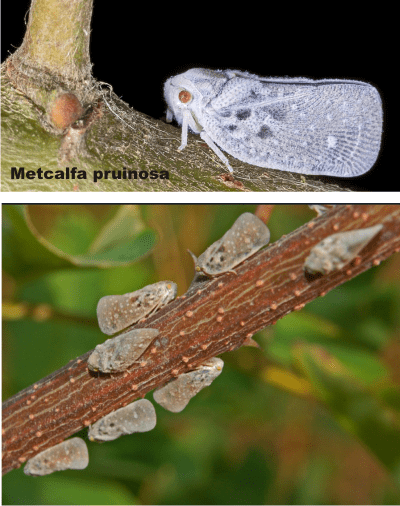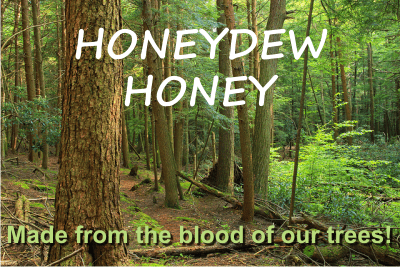METCALFA HONEYDEW HONEY is a different kind of honey. They are all different, you would say, yes, but this really is something special.
Everybody knows that honey is made by the honey bees from the nectar they collect from flowers. But this is not the case with honeydew honey. The term honeydew does not refer to a type of flower, or to melons. Honeydew is a liquid that honey bees find on the trees’ bark. They eat it and then regurgitate it back at the hive, transforming it then into honey.
What is this honeydew and how does it get on the tree bark? Well, this is a cute story. There are little insects, called aphids, that feed themselves from the tree sap. What they poop is this sweet liquid that we call honeydew. Grouse?
Honey bees won’t agree. For them it’s a sweet liquid that they can transform into delicious honey.
Types of honeydew honey
Honeydew honey can be different, depending on a lot of factors:
· the honeydew insect,
· the host plant on which the insect feeds (type of the tree),
· the weather conditions (temperature, relative humidity, wind speed-direction) during the honeydew collection.
· the annual production of honey per hive (Maurizio,1976).
What trees can give honeydew honey?
In Europe, the most common honeydew honeys come from coniferous evergreen trees such as
– fir (abies alba L. – in Central and Northern Europe,
– A. cephalonica Loudon – Greece,
– Picea excelsa (Lam) Link. – Central and Northern Europe,
– Pinus halepensis Miller,
– P. brutia Ten.- Greece,
– Latifoliae (produced in most of Europe, mainly from different Quercus species).
Honeydew is also common on other trees such as: citrus, oak (quercus), chestnut (castanea), lindens (tilia).
What insects make honeydew?
From the insects that produce honeydew: aphids, hellenica (which feeds both on pine and fir trees (stenophagous species), sugar cane leaf-hopper (Perkinsiella saccharidica) and metcalfa.
Metcalfa honeydew honey vs honeydew honeys
Though different types of honey are made of honeydew coming from different kinds of insects, beekeepers classify this whole class in only two categories: Matcalfa Honeydew honey and Honeydew honeys. The explanation is given by the fact that the main physicochemical parameters of the respective honeys show quite homogeneous values, with the exception of honey from honeydew produced by Metcalfa pruinosa, which has some some specific characteristics.
Therefore only this type was kept separate, whereas all the other types are grouped in one global class of “honeydew honeys”.
What is “honeydew”?
There are lots of details in the article What is honeydew honey?, but here is a suggestive picture in which you see the aphids (the black or green bugs) that suck the tree sap and then poop those droplets of clear liquid – eaten by ants in these pictures. These aphids are common on coniferous trees.

What is metcalfa?
An insect, on its complete name, Metcalfa pruinosa, aka citrus flatid planthopper. It is native to North America (Nearctic ecozone), but it was introduced to Europe at the end of the 1970s and has now spread to Austria, France, Italy, Slovenia and Switzerland, even in South Korea, where it attacks many plants giving rise, in summer, to significant quantities of monofloral honey.

Metcalfa pruinosa can reach a length of 5.5–8 millimetres (0.22–0.31 in) and a width of 2–3 millimetres (0.079–0.118 in) at the widest point. Their color turns from white when larva and nymph, to brown to gray in adults. They have large, yellow, compound eyes and a mouth adapted for piercing and sucking.
The female lays about 100 eggs, usually in the bark of host plants. Eggs overwinter and hatch the following spring. The adults are seen in summer and fall, feeding on sap. After that hey eject excess sugar in the form of honeydew.
This may be considered the only good part related to the existence of these insects. Otherwise they cause serious damages to field crops and ornamental plants.
The plants that are usually hosts for them include: maples, dogwoods, hawthorns, willows, elms, privet, black locust, and elder but also grape, citrus, apricot, peach, blackberry, and raspberry.
How is metcalfa honey?
Metcalfa honeydew honey has some characteristics that sets it apart from the other honeydew honeys. It has high values of colour, electrical conductivity, diastase, invertase, pH and acidity (even beyond the 50 meq/kg limit prescribed by the European Directive), positive values of specific rotation and low values of fructose, glucose, F+G and G/W.
Here are average values from 153 samples of honey from France and Italy, according to the study Main European unifloral honeys: descriptive sheets, by Livia PERSANO ODDO et al., from Italy,published in 2004 in Apidologie 35
Color: dark to very dark, with green fluorescence (100.8 mm Pfund)
Odor: woody, floral – fresh fruit (fruity), warm and vegetal, of medium intensity
Sweetness is low or medium
Bitterness: absent
Acidity: weak (total acidity 41.2 meq/kg)
Aftertaste: medium, sometimes astringent
Consistency: thick, due to a low water content
Crystallisation rate: slow
Electrical conductivity: 1.69 mS/cm
pH value: 5.0
Water content: 15.9 g/100 g
Diastase content: 39.3 DN
Invertase content: 172.0 U/kg
Proline: 515 mg/ kg
Fructose: 31.6 g/100 g
Glucose: 23.9 g/100 g
Sucrose: 0.1 g/100 g
Fructose / Glucose ratio: 1.34
The sugar spectrum of this honey type also includes a high dextrin content (after Fiori et al., 2000).
In the glucidic spectrum it shows a relatively high content of maltotriose and a low value of melezitose.
Under microscopic examination Metcalfa honeydew honeys are characterized by the presence of numerous honeydew elements such as: mold hyphae, spores, unicellular algae and pollen from nectarless plants.
The ratio HDE/pollen is mostly higher than 3.
Honeydew honey in the world:
Europe:
Honeydew honey has tradition here, representing an important honey flow for beekeepers, especially in all the alpine areas (central Europe).
– In Greece and Turkey, honeydew honey is mainly produced by Marchalina hellenica
– In northern Italy and some other countries, Metcalfa pruinosa is an important new honeydew producer.
– In France, the main producing species of honeydew are fire tree (Abies alba) and spruce (Picea abies). Other species, Scots pine (Pinus sylvestris), oaks (Quercus sp.), beech (Fagus sylvatica), larch (larix deciduas) can produce honeydew too but in lesser quantity. Since 1985, in the valley of Rhône it is possible to harvest honeydew from Metcalfa. Lime tree, chestnut, maple, poplar and willow also produce honeydew but often mixed with nectar.
Asia
According to Joshi (in 2000) the native bee species collect quite a lot of honeydew.
Australia and South America
Especially in Chile and Brazil bees collect honeydew from various insects and trees.

Africa
Beekeepers have observed bees collecting honeydew even on beans, clover, and wheat.
North America
Honeydew honey is not well-known here, though it is produced. It is commonly more known as Forest honey.
For example it is made from an insect, Margarodidae on Incense Cedar (Calocedrus decurrens) and was prized as White Cedar honey in California.
In Hawaii, honeydew was made by the sugar cane leaf-hopper (Perkinsiella saccharidica) and produced hundreds of tons of honeydew honey in the late 1800s and early 1900s.
Health benefits of honeydew honey
The best way to use honeydew honey is for prevention or treatment of at least the following conditions found in human and veterinary medicine:
· Infectious diseases (bacterial and viral related diseases),
· immune system diseases,
· large intestine diseases,
· diseases related to the presence of various toxins in the body,
· skin diseases,
· rheumatic and other degenerative diseases (like osteoporosis),
· inflammation related diseases.
The World Honeydew Honey Symposium
In 2008, the first edition of this event was held in Tzarevo, Bulgaria. The second one was held in Crete, Greece.
The BIOMIEL contest
At the 8th edition, the best Italian honey was the Metcalfa honeydew honey produced by Apicoltura Zipoli in Romanengo (Cremona).
In 2016 for monofloral honeys the first classified in absolute values was the Metcalfa honeydew honey by Alberto Pesavento, from Pordenone, italy, with the amazing score of 100/100. For honeys outside Italy, the best one was the oak honeydew honey by the Greek Melisses oi Magisses.
========
========
References and picture credits:
– Bibliographical review of the main European unifloral honeys, by Maria Gioia PIAZZA et al., published in Apidologie 35 (2004) S94–S111© INRA/DIB-AGIB/ EDP Sciences, 2004, DOI: 10.1051/apido:2004046
– Main European unifloral honeys: descriptive sheets, Apidologie 35 (2004) S38–S81 © INRA/DIB-AGIB/ EDP Sciences, 2004 DOI: 10.1051/apido:2004049
– Sensory Characterisation of Honeydew Honeys from Different Countries, by Lucia Piana, 2008. http://www.ihc-platform.net/honeydewsymposiumprogramabstract.pdf
– http://www.bulletinofinsectology.org/pdfarticles/vol57-2004-127-130bacandritsos.pdf
– https://www.bjcp.org/mead/MHS06.pdf
– Two metcalfa insects 0n featured picture – By Hectonichus – Own work, CC BY-SA 4.0, https://commons.wikimedia.org/w/index.php?curid=54781939
– Metcalfa insects picture by Hectonichus – Own work, CC BY-SA 3.0, https://commons.wikimedia.org/w/index.php?curid=15103269
– Metcalfa insect credit Didier Descouens – Own work, CC BY-SA 4.0, https://commons.wikimedia.org/w/index.php?curid=30352092
– BIOLMIEL 2016 Winners



